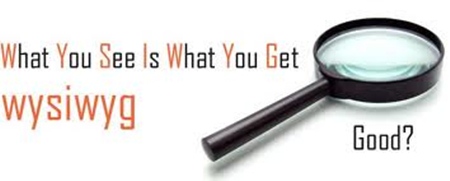If there ever was a “rule” of photographic composition that is ignored by most photographers, it is WYSIWIG. By breaking this rule you run the risk of being disappointed with your final result.
So, exactly what is WYSIWYG (pronounced “wizziwig”). It is the acronym for “What You See Is What You Get”! WYSIWYG works with picture-taking. It just needs one thing – you have to train your eye to see critically through the viewfinder.

We all tend to ‘imagine’ what is in front of us, rather than ‘seeing’ what is really there. Look at drawings of houses done by young children. Inevitably, there will be more than two walls. Children ‘know’ that houses have more than two walls, so draw houses accordingly. However, when you look at any house, from any angle, you can only see a maximum of two walls at one time. Small children do not use WYSIWYG.
Unfortunately, neither do many photographers. Hands up all readers who have reviewed their images from the memory card and been disappointed? All of you, if you are telling the truth – and that includes me!
What was wrong with those photos? Were there trees growing out of people’s heads, giving them strange reindeer ‘antlers’? Did some have such harsh shadows across the person’s face that you could not see the eyes, and in fact, the face looked grotesque? Did some have the person so small in the picture that you cannot tell who they are? Shall I continue, or since you have probably ticked the box for “all of the above”, let’s not prolong the agony, but get down to what we have to do to fix the problem.
The answer is very simply WYSIWYG, but you have to train yourself to ‘really’ see. We all know what we want to see in this once in a lifetime photo, but ignore the fact that what we are seeing in the viewfinder is not actually what we want. It’s the child and the house with three sides again.
You have to train yourself to look critically at what is in the viewfinder before going ‘click’. This is actually harder than it seems. You have to scan the small viewfinder to see if there are trees growing out of people’s heads. You have to squint at the faces and see if shadows are ugly. You have to be prepared to put the camera down and recompose the shot before clicking that shutter, remembering at all times that what the camera ‘sees’ is not necessarily what you are seeing with the naked eye.
That may sound a little weird, but it isn’t really. What the camera sees depends upon the lens you are using. The “standard” (50-55 mm) lens gives a field of view coverage approximately the same as the human eye, but the “wide angle” lenses (24 mm and 28 mm, are the common ones) give a distorted viewpoint compared to that seen by you. Likewise, the “long” lenses give a very narrow viewpoint compared to what you see with your own eyes.
This is probably one of the best arguments for the use of SLR cameras, because when you look through the viewfinder, you are actually looking through the lens that is screwed on the front of the camera. The compact cameras where you are not looking through the camera’s lens have a compensation for this, but it is a poor substitute. Who remembers which set of lines you are supposed to use as the edge of the shot when you are taking it? Nobody.
99 percent of serious photographers use SLR’s, and the main reason is WYSIWYG. Which brings me to the next important item. The Preview Button. Do you use it? Do you actually know where it is and how to use it? This is ‘real’ WYSIWYG. Did you realize that when you look through the viewfinder, you are looking through the lens with the aperture wide open? But your shot may be recorded at f16. The preview button allows you to see at f16 exactly what will be on the final print. Use it! What you see is really going to be what you get!




